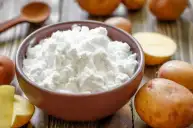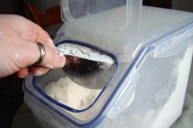Wondering when to use the different types of flour? You're not alone! There are so many varieties out there, it can be seriously confusing. To make matters worse, sometimes you can substitute one flour for another. Other times, if you use the wrong flour, the whole recipe can turn out funky!
To clear up any confusion you may have, we took a dive into the world of flours so you'll know when (and how) to use each of the major types. Let's get baking!
All-Purpose Flour
Also known as AP flour, this is the most commonly used flour. If your recipe doesn't specify a type, they're probably talking about all-purpose flour! This white flour doesn't contain the wheat germ or the bran, only containing the endosperm. This makes it more shelf-stable than whole-wheat bread, but also less nutrient-dense.
You might see all-purpose flour as "bleached" or "unbleached." If it's treated with chlorine or benzoyl peroxide, it must be marked as bleached. This bleaching process speeds up the curing process (making it easier to work with), but it also damages the protein and starch contents. If you have a sensitive stomach, you may prefer unbleached flour.
AP flour has a mild flavor that makes it work well for everything. This is my go-to flour for yeast breads and cookie recipes. Sift it through a mesh strainer or a flour sieve when making delicate baked goods like this recipe for soufflé.
Whole Wheat Flour
Whole wheat flour contains all three portions of the seed head (the germ, bran, and endosperm). The majority of the protein and fiber in the wheat plant are stored in these portions, so whole wheat flour is more nutrient-dense than white flour. It's also more absorbent (so you'll need more liquid to hydrate the flour) and it is prone to go rancid more quickly than the stripped white flour.
It's trickier to work with whole wheat flour because it makes a stickier dough, but it's totally worth it when it comes to the flavor. This is especially true in quick breads and bread recipes like this Shiner Bock beer bread recipe.
Cake Flour
Cake flour is specifically designed for making (you guessed it) cakes. It has a low protein content - while AP flour has a protein content of 10-11 percent, cake flour remains at about 8 percent. This makes it less chewy and gives it a spongier texture. This type of flour is perfect for making this cupcake recipe, along with any of your favorite cake recipes.
If you don't want to stock this flour in your pantry, an easy substitute involves cornstarch. Just take out 2 tablespoons of AP flour and replace it with 2 tablespoons of cornstarch. So, if your recipe called for 1 cup of cake flour, you would use 1 cup minus 2 tablespoons of AP flour and add in 2 tablespoons of cornstarch. Easy peasy!
Pastry Flour
Like cake flour, pastry flour is a soft wheat variety that has a lower protein content than AP flour. It has a delicate, fine grind which makes it more appropriate for pastries than AP flour. Since it has a lower gluten content than AP flour (but a higher gluten content than cake flour), it works really well for any pastry, muffin, or pancake recipe.
My favorite way to use pastry flour is in pie crust recipes. It's nice and tender with the perfect amount of chew. It's worth keeping a bag on hand just for pie season!
Bread Flour
Bread flour is the opposite of cake and pastry flours — it is has a super high protein content. It can be anywhere from 13 percent to 16 percent. This gives the flour some serious structure, which is really important when creating a chewy bread experience. After kneading this flour with a dough hook or by hand (with some serious elbow grease), you create a dense texture and crunchy exterior.
Bread flour obviously makes great bread, but don't feel like you have to limit your use to bread alone. This flour makes the best pretzels (like this pretzel bite recipe).
Rye Flour and Barley Flour
Barley is a type of wheat flour with a natural maltiness, and rye is technically a grain (not a type of wheat) that has a spicy flavor. Both are low-gluten flours with very strong, specific flavorings. They're both specialty flours that are popular for baking bread, but they are extremely hard to work with.
It's easy to end up with a gummy batter that doesn't rise, so making 100 percent foods with these flours is not recommended for beginners. It's good to start with 25 percent or less, like with this slow cooker Boston brown bread recipe.
Gluten-Free Flours
Naturally gluten-free flours like buckwheat flour are great for making pancakes and noodles, but they are dense and a little bit hard to work with. Buckwheat flour in particular has a nutty flavor that can sometimes be overpowering in the wrong recipe.
Nut flours like almond flour are gaining popularity for making gluten-free dessert recipes and as a breading alternative for fried foods. You may start to see other flours like cassava flour, which has become a go-to for gluten-free baking like biscuits and pie crusts.
It's important to remember that gluten-free flours lack the gluten protein, which means that a chewy network can't be built up via mixing or kneading. The baked goods created with these flours will be texturally different than their gluten-filled counterparts.
Ready to bake some bread? Get your flour of choice and baking powder ready. Start with these easy 15 cast iron skillet bread recipes.
This post was originally published on January 26, 2018.












